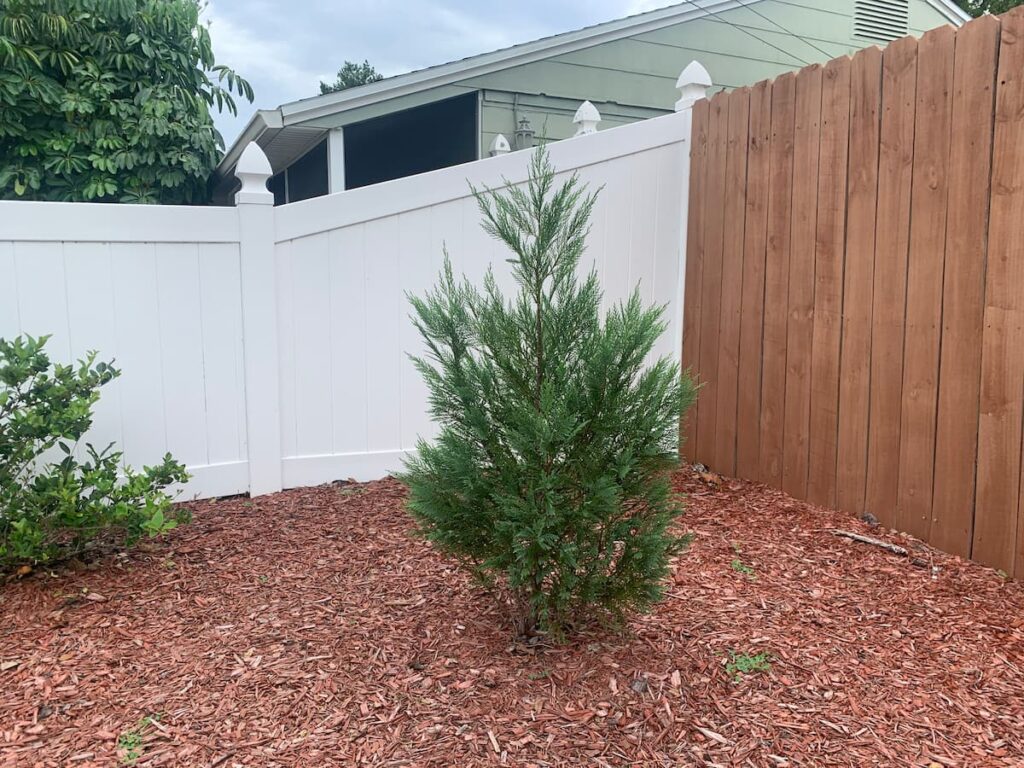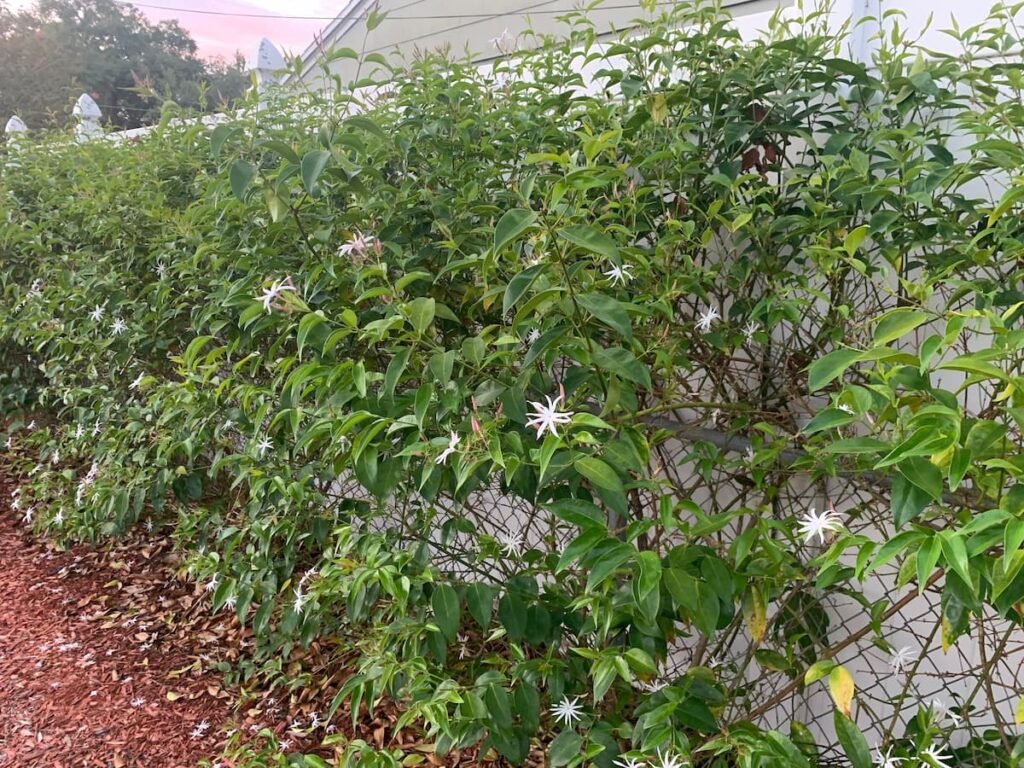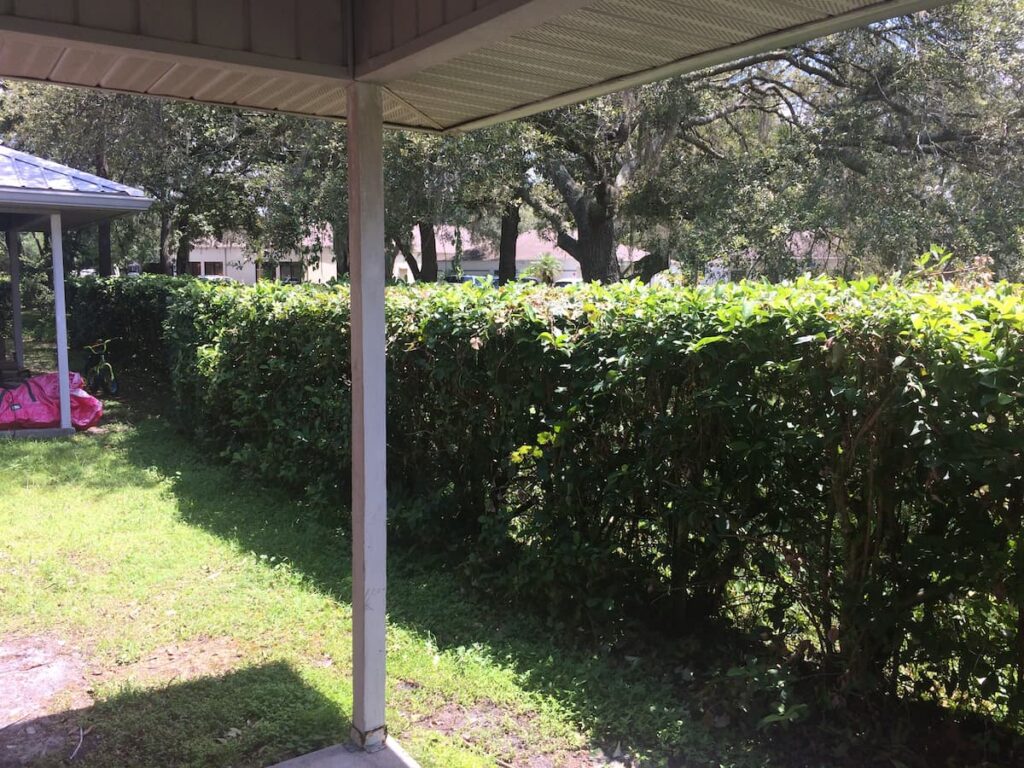I’ve been looking for the fastest growing plants for privacy screens in our yard. And let me tell you, we need some fast growing shrubs to help make our yard more private. Especially considering that when we bought our home it had virtually no shrubs and only a four-foot-tall chain-link fence surrounding the entire yard.
We’ve since constructed taller fences and planted an array of shrubs and trees. But it’s still somewhat like living in a fishbowl here on a corner lot. My wife and I have done lots of research on what the fastest growing shrubs for privacy are. The good news is there are many options for fast growing privacy shrubs out there. We’ve planted several in our yard, and they’re beginning to block out views of neighbors’ homes and the backside of other people’s fences. But we’ve got a ways to grow — I mean go!
As we tend our landscape toward its eventual maturity, I want to provide a rundown on the fastest growing plants for privacy. You may be shocked at just how fast some of these shrubs grow. I know I was when my wife and I planted many of them in our own yard.
List Of 8 Fastest Growing Plants For Privacy
What exactly are the fastest growing plants for privacy? The best privacy shrub really depends on where you live in the United States and the specific location or application for the given plant in your yard.
Arborvitae (Thuja occidentalis)
- Growth Rate: As much as 3′ to 5′ per year
- Mature Size: 50′ to 60′ tall by 12′ to 20′ wide
- USDA Hardiness Growing Zones: 3-9
- Growth Location: Full sun
- Notes: Arborvitae grows well as an ornamental, in groupings as a focal point, or in a hedge. We’re growing ours as an ornamental to anchor the corner of our front yard while providing something of a privacy screen from our neighbor’s front porch (we love our neighbor, by the way!). Arborvitaes are terrific evergreen conifers, and there’s a wide variety of them. My tip? Research the various kinds that grow in your USDA Plant Hardiness Zones and choose the kind that best suits your yard and its personality.

Beautyberry (Callicarpa americana)
- Growth Rate: 1′ to 2′ per year
- Mature Size: 3′ to 10′ tall by 3′ to 10′ wide
- USDA Hardiness Growing Zones: 7-11
- Growth Location: Full sun to dappled shade
- Notes: There are well more than 100 species of Callicarpa, and this one is perhaps one of the most popular in the Southeast. The magenta berries add a pop of color to any garden and are popular with squirrels and birds. You’ll probably like it for its showy qualities and propensity to grow tall and bushy — the perfect shrub for blocking out views at the one-story level.
Dogwood (Cornus florida)
- Growth Rate: As much as 1′ to 2′ per year
- Mature Size: 15′ to 30′ tall by 15′ to 20′ wide
- USDA Hardiness Growing Zones: 5-9
- Growth Location: Full sun (north) to part shade (south)
- Notes: My wife and I had no luck growing a dogwood in our Zone 9B locale of Central Florida. We think even in its most shaded location it was still just too hot to really ever get going. A grouping of three dogwoods at our local part met a similar fate. However, dogwoods do get along well around much of the country. They’re more commonly grown as an understory tree in the Southeast, though they do just fine in full sun in cooler climes. They lose their leaves in the autumn (after a terrific show of red fall color) but grow back beautifully in the spring.
Forsythia (Forsythia x intermedia)
- Growth Rate: 2′ to 4′ per year
- Mature Size: 10′ tall by 10′ wide
- USDA Hardiness Growing Zones: 3-8
- Growth Location: Full sun
- Notes: Most, but not all, forsythias are yellow in color, providing a beautiful bold look to any landscape. I love them and would’ve added some to our yard, except it’s just too hot for forsythias to do well in Central Florida. Many of my friends and family in the Northeast have grown forsythia. If you’re looking for a way to block out a less-than-desirable view, try forsythia if you can!
Lilac (Syringa vulgaris)
- Growth Rate: 1′ to 2′ per year
- Mature Size: 8′ to 12′ tall by 8′ to 10′ wide
- USDA Hardiness Growing Zones: 3-8
- Growth Location: Full sun
- Notes: Lilacs are a perfect choice for someone who wants a fast growing privacy shrub with showy, intoxicatingly fragrant flowers. My wife LOVES lilacs, but unfortunately, they’re extremely difficult to nearly impossible to grow in our Zone 9B region. Yet, a couple of very carefully tended lilacs are doing OK at my in-laws’ house a few miles down the street. However, lilacs are perfect for a privacy shrub points north of the 30th parallel.
Privet (Ligustrum lucidum)
- Growth Rate: Up to 3′ per year
- Mature Size: 25′ to 40′ tall by 25′ to 35′ wide
- USDA Hardiness Growing Zones: 7-10
- Growth Location: Full sun to partial shade
- Notes: As you can see, privets can reach various mature sizes depending on the variety. I’ve mostly grown glossy privet, which is one of the fastest growing plants for privacy in the Ligustrum family. It works well as a privacy screen. It’s also good for training as a tree — something I haven’t personally done yet but have seen in other landscapes to great effect.
Star Jasmine (Trachelospermum jasminoides)
- Growth Rate: 6′ to 10′ per year
- Mature Size: 25′ to 30′ long
- USDA Hardiness Growing Zones: 8-10
- Growth Location: Full sun to partial sun
- Notes: While star jasmine doesn’t like the cold, it does well in warm, humid climates — too hot though, and you’ll scorch its leaves! My wife and I love star jasmine for its citrusy fragrance and woody, intertwining vines. This climbing, fastest growing plant for privacy is perfect for filling in chain-link fences, as we have in our yard. Star jasmine is also ideal for adorning trellises, arbors, pergolas, and lampposts.

Sweet Viburnum (Viburnum odoratissimum)
- Growth Rate: 1′ to 2′ per year
- Mature Size: 25′ to 30′ tall by 15′ to 25′ wide
- USDA Hardiness Growing Zones: 8-10
- Growth Location: Full sun to partial shade
- Notes: One of my all-time favorite privacy shrubs, sweet viburnum is versatile, reliable, and does the job — at least at my Central Florida home. Creamy white flowers lead to little berries, satisfying pollinators as well as birds and squirrels. These plants can grow quickly. So, depending on how dense you want your hedge, you’ll want to make sure you plant your sweet viburnums at least 3′ apart — as much as 5′ apart or further still. A fastest growing plant for privacy, sweet viburnum does well as a good privacy screen as well as ornamental — and it can even be grown as a small tree.

Where To Buy The Fastest Growing Plant For Privacy
I like buying shrubs, trees, and other plants from my local garden nursery whenever I can. They usually have a pretty good selection of the plants I’m looking for and the expertise to help me know how to grow them.
If I ask them what the fastest growing plants for privacy are, they can take me right to it. Or, they can help me compare one fast growing plant to another so I can see my options.
Another option, as you’d guess, is the garden center at the home-improvement store. You’re bound to find fast growing plants there, too.
Fastest Growing Plants For Privacy Needs Time To Leap
Many people buy fast growing shrubs with the hopes — even an expectation — that these plants are going to start heading for the heavens right away. But that’s just not the way most plants grow. In fact, it can take a few growing seasons to really begin seeing your privacy shrubs start making your yard a little more private.
“The first year plants sleep, the second year they creep, and the third year they leap.” That’s an old gardener’s saying that I’ve found to hold true for so many plants.
You see, plants need time to establish and become acclimated to their environment. The first year, plants put a lot of their energy into building their root systems, stretching them into the soil. The next year, as plants begin adapting to their new setting, they’ll start putting out more growth. And usually by year three they are fully adapted to their environs and are growing at full tilt.
Of course, not every plant takes three years to start growing quickly. Others might take longer. But it’s a pretty good rule of thumb I’ve lived by for years now.
Caring For The Fastest Growing Plants For Privacy
Once you’ve planted your privacy shrubs, the hard part begins: making sure they become established enough to provide many years of privacy and enjoyment in your yard.
Water your plants at least for the first few weeks. Each plant has its own irrigation needs. However, most of the ones listed here will need at least an inch or two of water each week as they become established. A couple of deep soakings a week are always better than a light spritz every day. A kick start with some fertilizer can go a long way, but easy does it on the stuff. Over-fertilizing isn’t good for plants, either — and it can run off into local lakes and streams, causing algae blooms and other problems.
Don’t let your plants become heat stressed! If you see wilting leaves, be sure to water your plants right away. Early morning watering is best, but any time is better than none when plants look desperate.
Most of all, research the specific needs of each of the shrubs you’re planting for privacy. These guidelines aren’t one-size-fits-all. But if you want your fastest growing plants for privacy to reach their maximum size? Well, you’ve got to do a little extra legwork on what it takes to get the most out of your plant. Yet, a little knowledge can go a long way toward a natural — and successful — privacy screen in your yard!
